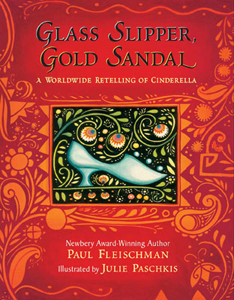
The Horn Book website has lots of material of interest to teachers. Here are some areas to explore. And follow us on Twitter: #lollysclass
|
Interviews with authors and illustrators Recommended books -- reviews and themed book lists |
School -- reading in school, author visits, and more Suggestion box: what else to you want to see in Lolly's Classroom? |
Glass Slipper, Gold Sandal | Class #5, 2015
One of the fascinating and mysterious things about folklore is that the same story types appear all over the world.
 One of the fascinating and mysterious things about folklore is that the same story types appear all over the world. Here's a single picture book that tells a Cinderella-type story as found in several different cultures.
One of the fascinating and mysterious things about folklore is that the same story types appear all over the world. Here's a single picture book that tells a Cinderella-type story as found in several different cultures.I think children would need to first be familiar with a single, cohesive version of this story in order to appreciate this book, but that is easily done. There are plenty of terrific stand-alone picture books of Cinderella, Cendrillon, etc., including our old friend John Steptoe's Mufaro's Beautiful Daughters.
What do you make of this one? Notice how the story is made cohesive, yet also kept separate, thanks mostly to Paschkis's illustrations and the book's design. Does this work for you? For children?

RELATED
RECOMMENDED
ALREADY A SUBSCRIBER? LOG IN
We are currently offering this content for free. Sign up now to activate your personal profile, where you can save articles for future viewing.






Add Comment :-
Comment Policy:
Comment should not be empty !!!
Quinn Dennehy
I want to echo everything everyone said! Has anyone ever watched the Chinese version of Cinderella on CBS Storybook? It was my favorite cartoon growing up, and I loved seeing the different cultures come through in this book. I used to teach fourth grade literacy, and one of our standards was to have students understand different cultural perspectives and expose them to many different cultures. This book would have been a perfect addition to our classroom library. What a well written and beautifully illustrated book!Posted : Apr 02, 2015 01:37
Ying Xiang Lai
As like everyone else, I was really impressed with how the author and illustrator managed weave the various cultures together along the main story line, which could have ended up horribly disjointed and confusing. Somehow, despite the different cultural references, the story still flowed well and was coherent. Similar to Rebecca, I had the impression that phrases such as “picking up the scorpion with her own hand” were local idioms and would have liked a more detailed description of each culture at the end of the book. Nevertheless, this book brought a breath of fresh air to the traditional folktale and I especially enjoyed the last spread where all the cultures came together in a harmonious way.Posted : Apr 01, 2015 09:38
Rebecca Tan
I loved how this books seamlessly integrated different cultures and really highlighted their unique features in the retelling of a familiar tale, Cinderella. From the map in the beginning to help children visualise or contextualise the different places mentioned, to the different types of clothing that different cultures would wear to a ball, these features were integrated neatly into the story in a way that did not disrupt the narrative but also helped me learn more about each place. I'm sure the version most are familiar with is the Disney version, however, what I appreciated was that this story revealed different dimensions to the same story. For example, that the girl felt that she had brought it upon herself by "picking up the scorpion with her own hand" and did not want to tell her father and upset him could be an example of the cultural influence on the story.Posted : Apr 01, 2015 02:34
Stacey Kahn
It’s interesting – when I first saw this book and glanced at its title, I thought I’d be disinterested and disengaged. Another Cinderella story? I thought. But when I cracked this book open, it wound up being one of my favorites of the week. The illustrations are beautiful; the way they seamlessly transition with the different cultures is breathtaking. The diverse cultural perspectives—especially those we are probably unfamiliar with as Americans, many of us perhaps even drawing from the Disney movie—were enlightening and cleverly embedded. Another version of this book could have easily been a disjointed presentation of multiple perspectives—in the wrong hands. But Fleischman and Paschkis show us that this story did, indeed, fall into the right hands, and they masterfully weave a multicultural version of a story into one cohesive (and colorful) whole.Posted : Apr 01, 2015 05:08
Joshua Jenkins
What made this book work for me was its originality--instead of another spin on Cinderella, it's an piecemeal anthology of several different cultures. While I read the introducion, I misunderstood its message at first, and it wasn't until a few pages in that I realized what was going on--I thought, "What culture is this with this array of food?!" And then, I looked a little more closely, saw the country names in the illustrations, and went back to the beginning soaking it all in. There can never be another folktale like this because it's the kind of appeal that only has novelty once, but I'm happy this is out there. I've often prompted kids to write regional versions of common folktales before, and I wish I'd known of this book! I will definitely use it in the future.Posted : Mar 31, 2015 11:09